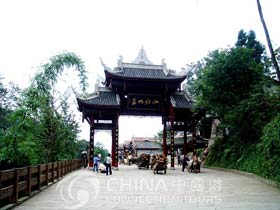
 Although Emeishan is still hugely popular with pilgrims, the mountain is equally famous for its spectacular scenery. The word "Emei" in Chinese means "Eyebrows of beauty" and locals believe that the peaks of Emei resemble the eyebrows of a woman! Towering 3099 meters high, Emei is the highest of China. Ermeishan Mountain is situated in the city of Ermeishan, which is 160kms to the southwest Ermeishan city and 37 km from Leshan City.
Although Emeishan is still hugely popular with pilgrims, the mountain is equally famous for its spectacular scenery. The word "Emei" in Chinese means "Eyebrows of beauty" and locals believe that the peaks of Emei resemble the eyebrows of a woman! Towering 3099 meters high, Emei is the highest of China. Ermeishan Mountain is situated in the city of Ermeishan, which is 160kms to the southwest Ermeishan city and 37 km from Leshan City.
Emeishan is one of China's four sacred Buddhist Mountains and has been a popular place of pilgrimage for the past 1800 years. The mountain stretches more than 200 kilometers from south to north. Its main peak, Wanfo Top, is 3,099 meters above sea level. Since ancient times Emei Mountain has been described as "Beauty under Heaven." Temples were built as early as the Eastern Han Dynasty (24-220) and Buddhism was introduced to the mountain during the Jin Dynasty. In the Ming and Qing dynasties there were more than 150 temples. A legend claims that the mountain was where Samantabhadra gave lectures on Buddhism and most temples house a statue of Samantabhadra. The main scenic spots on the mountain include the Baoguo Temple, Wannian Temple, Fohu Temple, Qingyin Pavilion, Heilongjiang Tunnel, Hongchun Platform, Xianfeng Temple (Jiulao Cave), Xixiang Pond and Golden Summit. These places are at different altitudes and have different climates. Temperatures at the top of mountain are 15 degrees lower than at the foot. The mountain, which supports more than 3,000 varieties of plants and many animals, is an important scenic area.
In this mountain, the natural scene and its long history melt together and assist each other. It has become the object of people to sing for. As the natural heritage, Ermeishan Mountain owns the typical vegetation form, which can assist the studies on world biota. In addition, its special geologic feature is the proof of biogenic derivation. As the cultural heritage, Ermeishan Mountain possesses the relics of Buddhism culture. Leshan Buddha is the most important one even in the world, which was built in the 8th century, 71-meter high. It took 90 years to finish this project. In 1996, it was ranked in “the world Cultural & Natural Heritage” by UNESCO (United Nations Educational, Scientific, and Cultural Organization).

